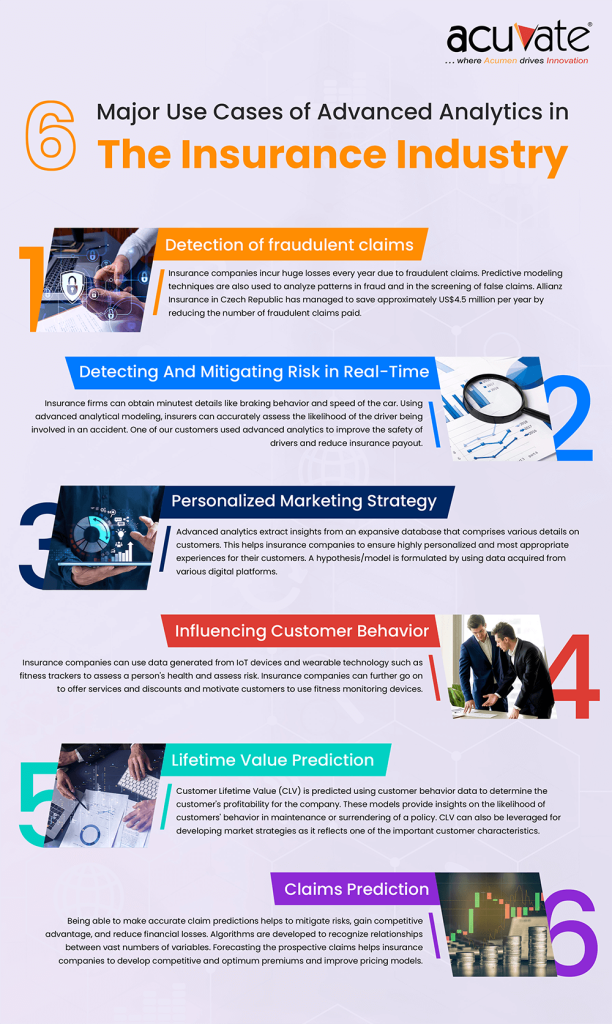The insurance industry is a high-risk sector. Navigating through tricky claims procedures, pricing and promotion, mitigating risks, cash repression, natural perils, ensuring compliance are some of the toughest problems that pose the industry. Traditionally, Insurance companies have long been dependent on statistics and data to drive their decisions, as there’s a plethora of data generated in this industry on a daily basis.
There’s been a paradigm shift in the working of insurance industries with the incorporation of advanced analytics to achieve their business goals. Advanced analytics helps to mine through big data for actionable insights which can be used for a plethora of business use cases. Insurers are increasingly using advanced analytics to not only protect their businesses from risks but also identify new growth opportunities using customer information.
6 Major Use Cases Of Advanced Analytics In The Insurance Industry

1. Detection Of Fraudulent Claims
Insurance companies incur huge losses every year due to fraudulent claims. According to Gartner, annual losses due to insurance claims fraud is estimated to be $40 billion per annum.
Many insurers also estimate that 10 – 20 percent of the claims prove to be fraudulent and detect less than 20% of the fraudulent claims.
Improvements in data science technology have made it possible to detect fraudulent activities, suspicious claims and behavioral patterns using predictive analytics that incorporates statistical models for efficient fraud detection. These models use historical data on fraudulent activities to arrive at specific conditions that predict the possibility of claims being fake.
Whenever a claim made by a person with a history of false claims is detected, the system halts the claim process and recommends an investigation on the case. Predictive modeling techniques are also used to analyze patterns in fraud and in the screening of false claims.
Allianz Insurance in the Czech Republic has managed to save approximately US$4.5 million per year by reducing the number of fraudulent claims paid and Poste Assicura in Italy has estimated savings of between 5 and 10 percent of claims with the help of advanced analytics.
2. Detecting And Mitigating Risk In Real-Time
Since the underlying nature of business in the insurance industry involves risk, advanced analytics is used to conduct real-time risk analysis that enables organizations to be quick on their feet in a volatile risk environment.
For instance, in the case of vehicle insurance, the ability to accurately assess the risk posed by a particular driver allows companies to formulate a competitive and profit-making premium. Cars connected to the internet can continuously transmit a large amount of data.
Insurance firms are now able to obtain the minutest details like braking behavior and speed of the car. Using advanced analytical modeling, insurers can accurately assess the likelihood of the driver being involved in an accident by comparing a driver’s behavioral data with their expansive database on the behaviour of other drivers.
One of our customers, a UK based waste management company, used advanced analytics to improve the safety of drivers and reduce insurance payout. The company predicted the probability of drivers having incidents by integrating telematics and tachograph infringement data with weather data and harnessing the data set with machine learning. With the help of the solution, the company drastically reduced the number of accidents and thereby the insurance payout.
3. Personalizing Marketing Strategies And Targeting Specific Customer Groups
Personalization is not a new concept in the insurance industry. Customers are willing to avail services that best suit their needs and lifestyle and to look for personalized offers, policies, loyalty programs, and recommendations.
In the era of extensive digital communication, insurance companies face the challenge of engaging their customers and communicating with them effectively.
Advanced analytics is fueled into extracting insights from an expansive database that comprises various details on customers like demographic data, preferences, attitude, lifestyle details, interests, belief systems among many others.
This helps insurance companies to ensure highly personalized and most appropriate experiences. A hypothesis/model on personalization and marketing strategies are formulated by using data acquired from various digital platforms which are then tailored to fit the customers need. Several analytical tools and mechanisms help companies achieve this outcome.
Personalizing offers, policies, prices, recommendations, and marketing ads attribute to the success of acquiring customers and in turn increase the insurance rates of a company.
4. Influencing Customer Behaviour
Advanced analytics has also been used by insurance companies to analyze telematics data and influence customer behavior. For instance, health insurance companies can capture data generated from IoT devices and wearable technology such as fitness trackers and analyze it to track variables that determine the health of a person and assess risk.
By monitoring behavior and habits, insurance companies can provide a comprehensive assessment of their customers’ health and urge customers to take better care of their health, thereby mitigating the risks involved. Insurance companies can further go on to offer services and discounts and motivate customers to use fitness monitoring devices.
John Hancock Financial, a renowned life insurance company, offers its customers with discounts on their premiums and a free Fitbit wearable monitor so that customers can work to reduce their premiums by presenting an evaluation of how they are progressing on their unhealthy and risky behaviors.
5. Lifetime Value Prediction
Customer Lifetime Value (CLV) is predicted using customer behavior data to determine the customer’s profitability for the company. Behavior-based predictive models are used to process all the data on customers and arrive at a forecast on customer buying and retention.
These models provide insights on the likelihood of customers’ behavior in maintenance or surrendering of a policy. CLV can also be leveraged for developing market strategies as it reflects one of the important customer characteristics.
6. Claims Prediction
Predicting the turn of events in the future is of paramount interest to the insurance industry. Being able to make accurate claim predictions helps to mitigate risks, gain competitive advantage and reduce financial losses.
Advanced analytics propels some of the most complex processes involved in building financial models that have a large number of variables affecting the outcome. Algorithms are developed to recognize relationships between vast numbers of variables and detect several important parameters that are essential to build customer portfolio.
Forecasting the prospective claims helps insurance companies to develop competitive and optimum premiums and improve pricing models.
Wrapping Up
Advanced analytics is an indispensable tool to stay ahead in the insurance industry. Early adopters who are leveraging this technology for just 1-2 use cases like claim handling, detecting fraudulent claims, etc., are already saving claim costs in millions of dollars. Acuvate has helped several large and medium-sized insurance companies implement advanced analytics using Microsoft technologies like Power BI, Azure Machine Learning, Azure Analysis Services, Azure Databricks etc.
If you’re planning to implement advanced analytics solutions in your organization, please feel free to reach out to one of our big data analytics consultants for a personalized consultation. You may also be interested in exploring our business intelligence and analytics services and solutions.



